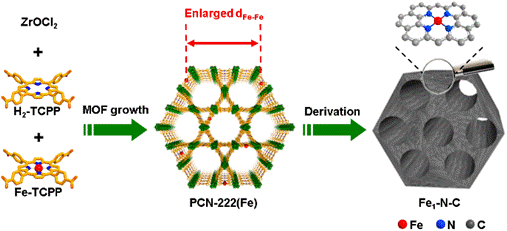| Single-atom Catalysts Templated by Metal-organic Frameworks for Electrochemical Nitrogen Reduction |
| From: PublishDate:2020-07-29 Hits: |
Single-atom catalysts (SACs), presenting the remarkable activity and high selectivity, are of great significance for mechanism exploration and practical applications of chemical reactions. Nevertheless, due to the challenge in controlled synthesis, the environments of single-atom sites in reported SACs are usually different, even with the same metal site and support. Metal-organic frameworks (MOFs), a class of crystalline porous materials with structural regularity and synthetic tunability, are recognized to be the ideal platform for the general synthesis of single-atom catalysts with the identical structure. In this work, a porphyrinic Zirconium MOF, PCN-222, has been selected as the precursor. By varying the metal species incorporated in the porphyrin center of PCN-222, a series of single-atom metals (Fe, Co, Ni) implanted in N-doped carbon (denoted as Fe1-N-C, Co1-N-C and Ni1-N-C) with identical structures, were successfully constructed and used as model electrocatalysts for nitrogen reduction reaction (NRR) (Figure 1). This research, which was entitled ‘Single-atom catalysts templated by metal-organic frameworks for electrochemical nitrogen reduction’ and published in the J. Mater. Chem. A, was carried out by professor Hai-Long Jiang and several co-authors from University of Science and Technology of China (USTC).
Figure 1 The synthesis of Fe1-N-C from PCN-222(Fe). By virtue of the 1W1B XAFS beam line of Beijing Synchrotron Radiation Facility, the researchers studied the structures of the catalysts. In the Fe K-edge X-ray absorption near-edge structure (XANES) spectra, Fe1-N-C exhibits an energy absorption profile locating between Fe foil and Fe2O3. Fourier transform-extended X-ray absorption fine structure (FT-EXAFS) curve of Fe1-N-C presents a main peak at ca. 1.4 ?, corresponding to Fe-N coordination. The Fe-Fe peak at 2.2 ? cannot be observed, exhibiting the exclusive existence of single-atom Fe. Furthermore, according to the EXAFS fitting result, single Fe atom is coordinated by 4 N atoms. In the electrocatalytic NRR, Fe1-N-C shows a Faradaic efficiency of 4.51% and ammonia yield rate of 1.56×10-11 mol cm-2 s-1 at -0.05 V versus reversible hydrogen electrode, superior to those of Co1-N-C and Ni1-N-C. Theoretical calculations reveal that the electrocatalytic performance is closely related to the energy barrier of the rate-determining step. Fe1-N-C shows the lowest energy barrier of the rate-determining step during the NRR process, consistent with its highest activity obtained in experiments. This work reveals the superiority of MOFs for the construction of SACs and provides in-depth insights into the preparation of high performance NRR catalysts as well as the understanding of the catalytic mechanism. Meanwhile, the synchrotron radiation techniques represent an advantage in the characterization of catalyst structures. Article: Rui Zhang, Long Jiao, Weijie Yang, Gang Wan and Hai-Long Jiang,* Single-atom Catalysts Templated by Metal-organic Frameworks for Electrochemical Nitrogen Reduction. J. Mater. Chem. A 7(2019), 26371-26377. |
|
|
| Chinese
- Metal-free efficient photocatalyst for stable visible water splitting——Top ten major scientific progresses in China in 2015
- The nano-resolution imaging platform was awarded the first rate prize of Beijing Science and Technology in 2014
- Beamline 1W1 of BSRF started to runoperate in the couplingparasitic mode of BEPCII
- Synthesis of High Performance Polymer Materials for Field Effect-Transistors
- Surfactant molecular aggregates in green solvents
- GIXRD has played an important role in the characterization of organic thin-film transistors
Science Highlights
Home /
Copyright © 2011 - 2012 Beijing Synchrotron Radiation Facility


